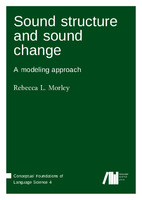Sound structure and sound change
A modeling approach
| dc.contributor.author | Morley, Rebecca L. | |
| dc.date.accessioned | 2020-03-10 03:00:38 | |
| dc.date.accessioned | 2020-04-01T09:14:36Z | |
| dc.date.available | 2020-04-01T09:14:36Z | |
| dc.date.issued | 2019-10-23 | |
| dc.identifier | 1006734 | |
| dc.identifier.uri | http://library.oapen.org/handle/20.500.12657/23418 | |
| dc.description.abstract | Research in linguistics, as in most other scientific domains, is usually approached in a modular way – narrowing the domain of inquiry in order to allow for increased depth of study. This is necessary and productive for a topic as wide-ranging and complex as human language. However, precisely because language is a complex system, tied to perception, learning, memory, and social organization, the assumption of modularity can also be an obstacle to understanding language at a deeper level. This book examines the consequences of enforcing non-modularity along two dimensions: the temporal, and the cognitive. Along the temporal dimension, synchronic and diachronic domains are linked by the requirement that sound changes must lead to viable, stable language states. Along the cognitive dimension, sound change and variation are linked to speech perception and production by requiring non-trivial transformations between acoustic and articulatory representations. | |
| dc.language | English | |
| dc.subject.classification | thema EDItEUR::C Language and Linguistics::CF Linguistics | en_US |
| dc.subject.other | Linguistics | |
| dc.title | Sound structure and sound change | |
| dc.title.alternative | A modeling approach | |
| dc.type | book | |
| oapen.identifier.doi | 10.5281/zenodo.3264909 | |
| oapen.relation.isPublishedBy | 0bad921f-3055-43b9-a9f1-ea5b2d949173 | |
| oapen.relation.isFundedBy | b818ba9d-2dd9-4fd7-a364-7f305aef7ee9 | |
| oapen.relation.isbn | 9783961101900 | |
| oapen.place.publication | Berlin | |
| oapen.grant.number | 104953 | |
| oapen.grant.program | Language Science Press 2018 - 2020 | |
| oapen.identifier.isbn | 9783961101900 | |
| grantor.number | 104953 |

